Published in 2016
Created by Jacob Fryxelius
Published by FryxGames and Stronghold Games
No. of Players: 1 – 5
Playtime: 90 – 120 minutes (but definitely can go longer)
Age: 12+
When I wrote the Scythe blog a few months back, there was another game that seemed to be talked about just as much as Scythe. I didn’t know much about Terraforming Mars, but reviewers were impressed by both its thematics and mechanics. The reasons why I didn’t pay too much attention to this game was both its cost and its gaming weight. I didn’t want to pay at least seventy dollars on a game that, after looking at the rules, seemed really heavy. I look for games that would engage a broad spectrum of people and Terraforming Mars seemed to be a game that would entertain only those who are highly competent in tabletop gaming.
Fast forward to July where my friend Mike buys his own copy of Terraforming Mars. He and many of our friends absolutely praise this game. Again I question, “what was with all the fuss about this game?” So I tried it. Sure enough, after playing one game, I wanted to play again. And again. And then I bought my own copy with the Broken Token Tray sets so that the cubes could lock into place on the player mat. I even tried to find ways to play this game whether it be playing the solo variant when my fiance’s away at work, or playing with a variety of casual or avid gaming groups in Calgary. Heck, when my fiance, her family, our friend Connie and I stopped by Snakes and Lattes in Toronto for the first time, the only game I grabbed from the shelf was Terraforming Mars and said to the group “we have to play this!”
…Okay it sounds like I’m a little addicted to this game, but rest assured, I express the same amount of excitement for Terraforming Mars as I did for Scythe because it is ridiculously good and I regret not getting this game sooner.
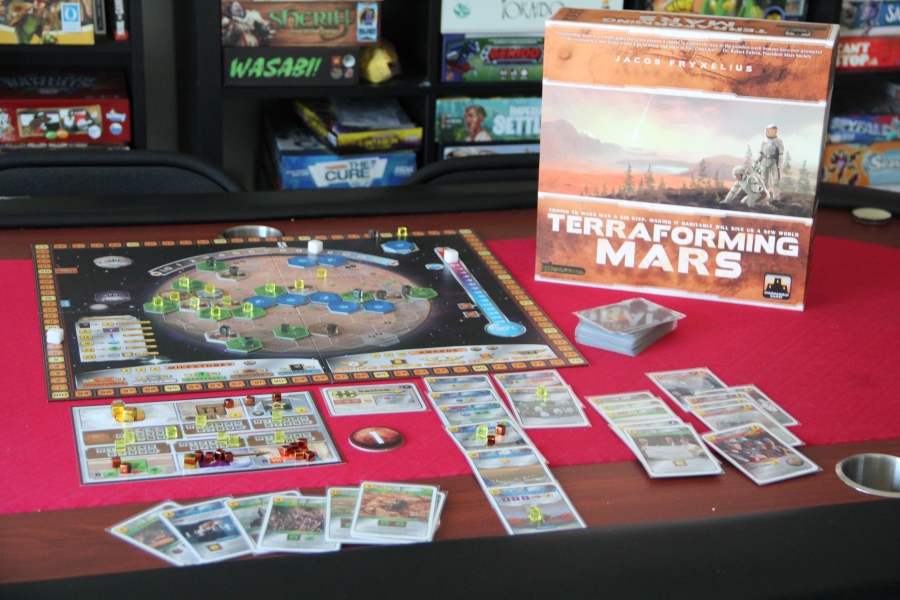
Terraforming Mars is a card drafting, tile placement game created by Jacob Fryxelius and is published by FryxGames and Stronghold Games. Terraforming Mars was also a 2017 Kennerspiels des Jahres nominee. In this game, you play as a futuristic corporation, trying to terraform Mars and earn points based on how you contribute to the planet’s terraforming. This is done in a variety of ways. The main ways are through increasing the planet’s oxygen percentage, adding oceans to the planet, or increasing the average temperature. Players buy and play a variety of project cards, each one with a unique way of adding to the planet, from placing plants and foliage, mining various parts of Mars or even Jupiter, building cities on Mars, or even nuking or attracting asteroids to the planet. The player who is able to terraform Mars the best is the winner.
Setup for Terraforming Mars is not too bad. For this review we’re going to assume that we are playing the Corporate Era, that is, we will be utilizing the different abilities that each corporation has. If you are playing for the first time, you will be using the beginner corporations, which all have the same ability and the same amount of starting capital. Place the board in the center of the table. Each player takes a player mat and their player cubes, and place the cubes on the zero of their production track. This is indicated by the brown background. Each player will also randomly draw two corporate cards, and choose one of them. Each corporate card tells you the starting income, as well as whether or not you have additional resources or production. It will also give you a special ability throughout the game. To indicate the income or resources you have, you will place the gold, silver, or bronze markers in the supply portion of your mat, gold being worth ten, silver worth five and bronze worth one. So for example, if you wanted to show that you start with 42 dollars and 5 metal, you could possibly put four gold and two bronze on the money section of the mat, and put one silver in the metal section. Place the three white markers on the board, one will go on 0% on the oxygen track, another will go on -30 degrees Celsius on the temperature track, and finally the last one will be on the 1 on the point track, which also acts as a generation track. Place the nine ocean tiles in the upper right corner and then have all the planet tiles somewhere within reach for each player, separating the foliage/city tiles from the special ones. Finally, give each player 10 cards from the deck. You must pay three dollars from your money supply in order to keep the card and place it in your hand. Determine the starting player, hand that person the starting token and you’re good to go.
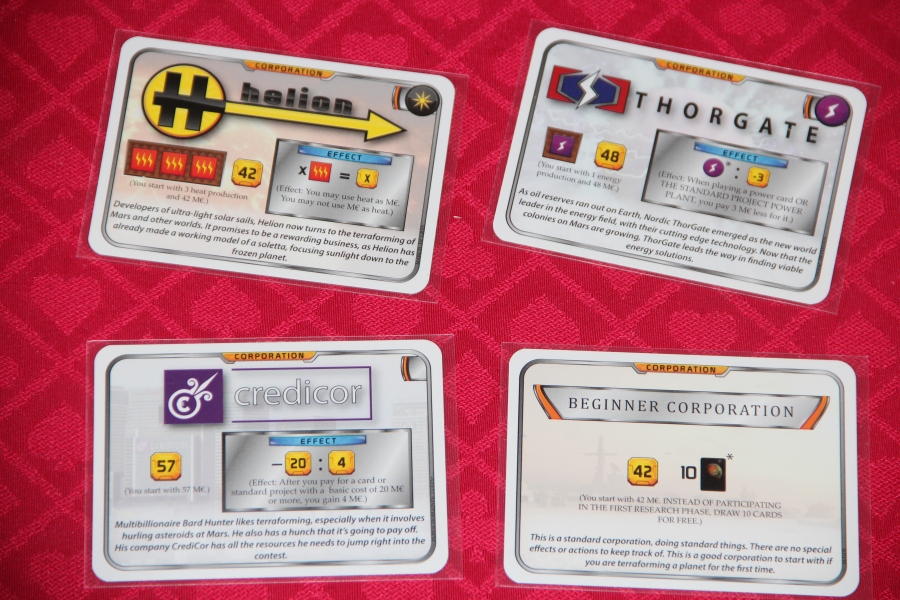
In Terraforming Mars, players try to terraform Mars by playing cards that will allow them to, in general, increase the production of resources for their corporation, which then in turn allows them to perform actions that will ultimately terraform the planet. At the beginning of the turn, players draft a number of cards by drawing four (or ten if it’s the first turn) and buying them for their own hand. Each card costs three dollars to be placed into the hand. Then each player can perform one or two of the following actions on their turn:
- Play a card from your hand – in order to play a card, you must check if there are any requirements on the card. For example, it may say that oxygen must be at 5% in order for you to play it. If the card meets the requirements, then you may pay for the card and gain the immediate effects.
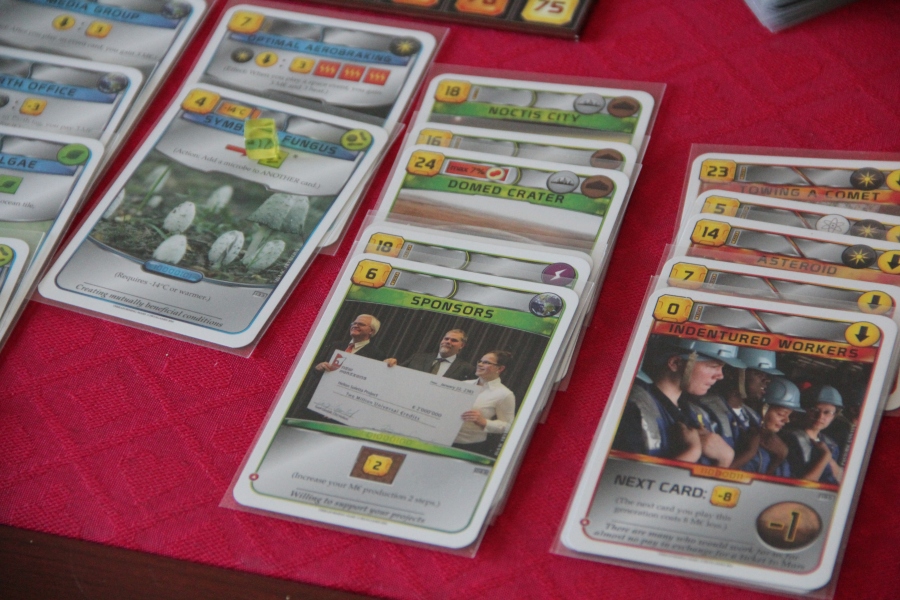
- Use a standard project – on the board there are standard projects that are available to each player by paying the indicated cost. They can sell their cards for more money, increase their energy production, increase the temperature, or place an ocean, greenery, or city tile on the board
On that note, there are certain rules for the tiles that are placed on the board. Ocean tiles are not owned by anyone, but when a tile is placed beside an ocean tile, the player earns two dollars. If a greenery tile is placed, it must be placed by another tile that is owned by the player, which increases the oxygen level by 1%. Also, greenery tiles are worth one point for the player who placed it there. If a city tile is placed, it can be placed anywhere, but it is worth one point for every greenery tile adjacent to it regardless of who owns the greenery tile. If you placed a city tile using a standard project, your money production also increases by 1.
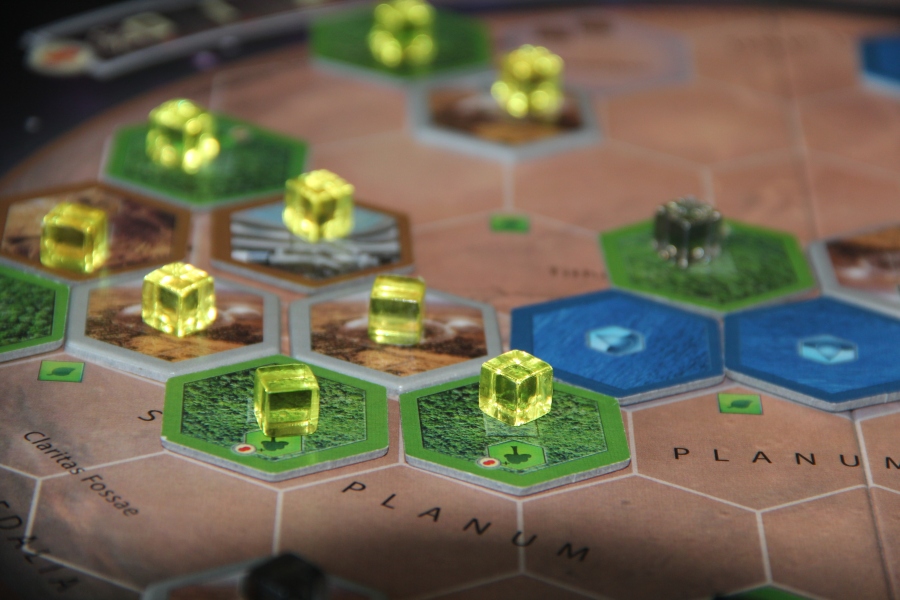
- Claim a Milestone – If during the game you are able to complete one of the five milestones located on the bottom of the board, then you can claim it by paying eight dollars and placing one of your player markers on the milestone. Also know that each milestone can only be completed by only one player, and only three of the five milestones can be completed.
- Fund an award – Only three awards can be funded during the game, and this is done by paying the money indicated on the board. The first player to fund the award only has to pay 8 dollars, the next player pays 14 dollars, and the third player pays 20 dollars. At the end of the game, victory points are awarded to the player who wins that category, so it is possible that the player who funded the award may not necessarily win it.

- Use a blue card’s action – some of the cards that were played give the players an extra action. Each action can be played once per generation and you get whatever resources that are found on the card.
- Convert plants into greenery – When you’ve saved enough plants in your supply, you can spend eight of them to get a greenery tile. This increases the global oxygen level by 1%.
- Exchange heat to increase the temperature – You can also spend eight heat markers to increase the temperature two degrees.
Also remember that any time you either put an ocean tile on the board, increase the oxygen level 1% or raise the temperature two degrees, you also get an increase in your terraforming rating. Players continue performing actions until they pass. Once they pass, they cannot perform any more actions until every other player has passed. After every player has passed, a production phase happens, in which players receive resources based on what they have on their production tracks. The game continues until all three global parameters have reached its maximum, in which case players get one more chance to use plants to get a greenery tile. All players then calculate their final score by adding to their current terraforming rating the award points they have won, the milestones they have achieved, the tiles they own on the board, and the bonus or penalty points found on the project cards played. The player who has the best score wins.
Terraforming Mars is as good as people have been saying. I’ll start with the components. I find it innovative to use communal resource cubes to determine how much of each resource a player has. The special tiles have some really cool symbols that are easy to find when you are looking for a specific tile. The cards also feature lifelike artwork and I even wonder if some of the cards use real photographs. More importantly the cards are easy to read and iconography is highly intuitive, which is awesome for a game this heavy. The only issue I have is the player mat. The cubes can be easily shifted, which means that cubes could be mistaken as a different resource. It was one of the reasons why I bought a set of game trays from Broken Token.
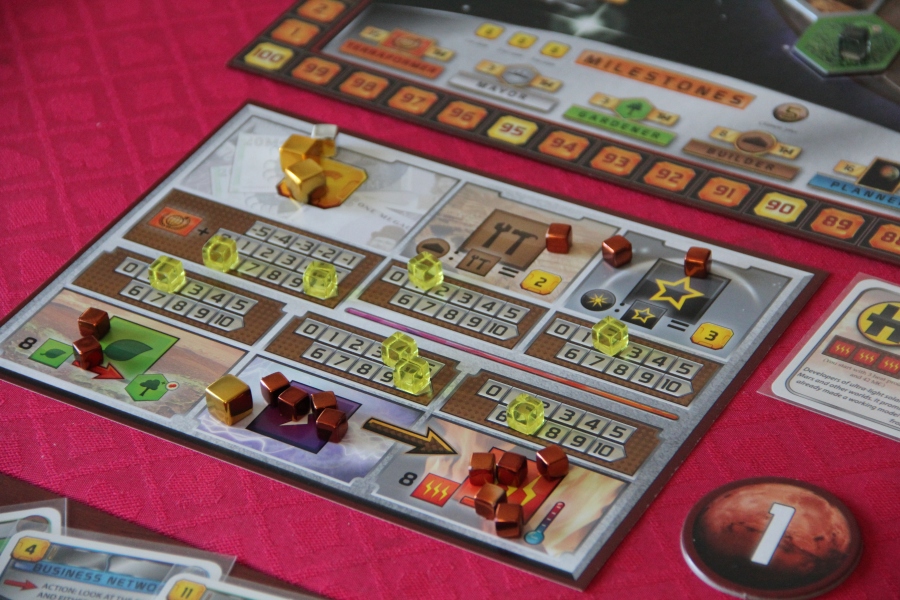
I’ll admit, Terraforming Mars is difficult at first, but once you get the general motion of the game, it is really entertaining to play. I think I said this about Scythe too, but this is one of those game where you can focus on one of a variety of strategies, all of them being equally good. These strategies are steered by what corporation you draw at the beginning of the game, but you still have control of what route you’re going to take in order to win. In the games that I have played, I haven’t used the same strategy twice. Sometimes I would focus on terraforming the planet and get points that way. Other times, I would direct my efforts on getting the milestones and awards before my opponents did. There are times also where I would highly optimize the cards I’ve put in my tableau. In most of the games that I’ve played, the scores are pretty tight and everybody just had a good time playing this game.
Player interactions within the game are also very interesting. These clashes become apparent when you are only given two actions to work with each turn. I often felt that there was pressure to do certain actions because my opponents were doing specific things. For example, if I noticed that my opponent was playing a lot of greenery tiles on the board to get the gardener milestone, it encouraged me to either play aggressively and destroy their plant production while increase my own, or play passively and try to get another award that they were obviously not going for. The awards mechanism also encourage these tensions between players. A lesson I’ve learned from playing Terraforming Mars is that you can’t be too comfortable with a lead because it can be easily taken from you if you are not careful. You could feel like you are safe with getting the bankers award because your money production is so high, but then a few rounds later lose the award because many other players start concentrating on their own money production. Finally, since a majority of the tiles give you points, I felt that there was this almost “Blokus-like” effect where your placement will definitely affect where others are going to go. The player interactions in this game are intricate and complex, but what ends up happening is that you have a highly engaging game for all players.
Terraforming Mars is an addicting game and is hands down one of the best games that I have played. The biggest reason why I love this game is because of how it brings out my inner science geek. I love how many scientific elements are in it, such as how wasted energy becomes heat, or how oceans are created by melting polar ice caps. I also love how there is a varying difficulty so that beginner players can enjoy the game just as much as the veterans. The game scales well for all player counts, even as a solo game where you are trying to Terraform the planet by yourself and have even less resources to work with. I’ll admit the game is fairly long and starts off very slow, but the game ramps up exponentially as players are starting to generate their engine in terraforming the planet, and because of the interactions between players, the game doesn’t feel lengthy at all. You feel like you are constantly juggling between your own production and the clashes you have with other players. And at the end of most games, players feel good because of the tight scores and how it came down to one card or one award. In the next month or so, if there is ever a games night, I will always make a push to play this game. Terraforming Mars is definitely worthwhile to add to your games collection.
Pros:
- Immersive gameplay; you feel like you are terraforming the planet.
- Strong and intricate player interactions.
- Multiple strategies to win, all of which are good.
- Great components and stellar artwork.
- Easy to understand iconography on the 200+ project cards.
Cons
- This is a heavy game. Your “rules person” is going to read the rules a fair bit to understand what’s going on or you need to watch a Youtube video on how to play.
- This a long game. (two to four hours long). Be ready to stretch your legs once in awhile.
- Be careful with bumping the player mat. Resource cubes and player cubes can be easily shifted.

